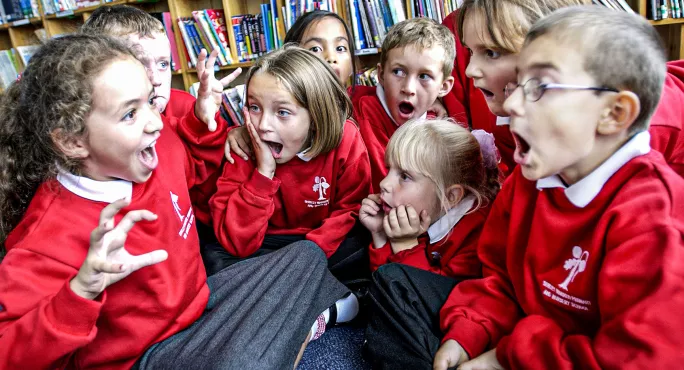- Home
- Teaching & Learning
- Primary
- How classroom stories can help to heal trauma
How classroom stories can help to heal trauma

“Tell them stories and let them tell their stories. Through stories they can start to heal.”
That was the advice from a Trauma Informed Schools UK training session I attended in 2021.
As a teacher for nearly three decades and also a children’s writer, I have seen first-hand the power of stories to help children frame or express difficult experiences and make sense of trauma.
And there is perhaps a greater need for this now more than ever. UK schools are witnessing an exponential rise in mental health issues, particularly in key stages 2 and 3. In 2022 18 per cent of children aged 7 to 16 had a probable mental health disorder, up from 12 per cent in 2017, according to NHS figures.
But can stories really help? And how can therapeutic storytelling be practically achieved in a school setting?
Stories help pupils to cope with trauma
Kim Golding is an author and works with Trauma Informed Schools UK, and says it’s all about the power of meaning-making.
“More is now understood about the importance of narratives upon how children think and understand their own feelings, fears and desires,” she explains.
“We have many terms to name this, including mentalisation, emotional literacy and reflective thinking. In essence, it is the almost magical power of storytelling to transform and heal.”
Related:
- Mental health: Are schools being asked to do too much?
- Teachers spend increasing time on mental health support
- Why wellbeing should drive policy and practice in schools
Dr Margot Sunderland, director of education and training at The Centre for Child Mental Health in London, also notes the transformative impact such stories can have on classroom behaviour.
“When a child’s too-difficult or painful feelings are left untalked about, they leak out in difficult and challenging behaviours,” she says.
But when a child is helped to think about their troubled feelings through story and to develop emotional literacy, it can “prevent these feelings from building up into an awful mess inside”.
“For a child, common feeling labels such as ‘cross’, ‘sad’ or ‘scared’ fail to marry up with the sheer force of feeling she experiences,” Sunderland explains.
“In contrast, stories can speak about feelings with amazing richness. A child can enter, through the story world, into a world of hope, options and possibility in the form of healthier, more creative coping mechanisms.”
This underpins so much of what I do as both a teacher and author. In my latest novel Bird Boy, Will is struggling with obsessive compulsive disorder (OCD) and anxiety after the death of his mother. His relationship with an injured osprey allows him an outlet for his own feelings of abandonment, fear and displacement. I wrote it as a response to the heartbreaking spike in mental health problems I witnessed in the wake of the pandemic. Because stories have the power to heal, they offer hope.
The simplicity of storytelling
So how can teachers deploy storytelling techniques to help? Primarily, by simply reading. Without worksheets, follow-up tasks and so on - just sharing a story.
According to a recent report by Farshore, only 24 per cent of children aged 7 to 10 are read to daily at school purely for enjoyment. Instead, reading often becomes associated with comprehension exercises, fact retrieval, tests and worksheets.
Farshore recently launched its Storytime in School research project to test the impact of daily storytime on children’s attainment and wellbeing. The study saw teachers reading to children for at least 20 minutes each day, purely for enjoyment and with no formal teaching attached, and found positive impacts.
“Teachers and pupils believed that storytime had boosted children’s mental wellbeing and supported the development of social skills,” the report states. “Many talked about the welcome feeling of ‘calm’ during storytime and said that they timed it strategically to support key transition points in the day.
“Many teachers themselves reported that reading to their children had left them feeling calmer and happier, too. Others talked about the way in which storytime had strengthened the bond between themselves and their class.”
Embedding stories within and alongside the personal, social, health and economic (PSHE) education curriculum can also be powerful. At my school, we recently introduced The Year 7 Big Read, using a collection of short stories that covers issues ranging from autism to OCD, adoption, immigration, racism, anxiety and young carers.
The stories were short enough to read in one or two sittings, usually during morning registration, and such tales can be shared by non- English specialists or read aloud by pupils themselves and used to open up informal discussion and debate.
The aim is to link to aspects of the KS3 PSHE curriculum, to enhance the discussions happening around personal, social, health and economic issues. But the link is tangential, allowing discussion to be more organic than didactic, providing space for quiet, meaningful and much-needed reflection in the hectic school day.
Catherine Bruton is an English teacher and multi-award-winning author of titles including No Ballet Shoes in Syria and Bird Boy
For the latest research, pedagogy and practical classroom advice delivered directly to your inbox every week, sign up to our Teaching Essentials newsletter
You need a Tes subscription to read this article
Subscribe now to read this article and get other subscriber-only content:
- Unlimited access to all Tes magazine content
- Exclusive subscriber-only stories
- Award-winning email newsletters
Already a subscriber? Log in
You need a subscription to read this article
Subscribe now to read this article and get other subscriber-only content, including:
- Unlimited access to all Tes magazine content
- Exclusive subscriber-only stories
- Award-winning email newsletters
topics in this article



